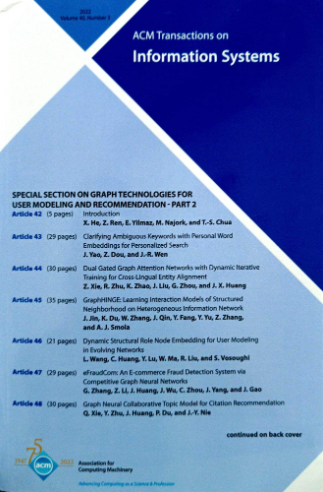用于回答事实实体问题的知识图谱嵌入模型
IF 5.4
2区 计算机科学
Q1 COMPUTER SCIENCE, INFORMATION SYSTEMS
引用次数: 0
摘要
类事实实体问题(FEQ)是从 DBpedia 和 Wikidata 等知识源中以单一实体的形式寻求答案的问题,在搜索引擎的用户查询中占有相当大的比重。本文介绍了用于事实实体问题解答的知识图谱嵌入模型(KGE-FEQ)。KGE-FEQ 利用从大量文本集合中提取的文本知识图谱,对实体之间的文本关系进行编码。该模型采用两步流程:(1) 三元检索,根据与问题的语义相似性从文本知识图谱中检索相关的三元;(2) 答案选择,利用知识图谱嵌入方法回答问题。这包括将答案实体的嵌入定位在问题实体的嵌入附近,并纳入一个代表问题和实体间文本关系的向量。广泛的实验评估了所提方法的性能,并将 KGE-FEQ 与事实实体问题解答领域最先进的基准以及应用于 FEQ 的最先进的开放域问题解答技术进行了比较。结果表明,KGE-FEQ 在不同的数据集上都优于现有方法。当回答问题时同时考虑实体之间的问题关系和文本关系时,消融研究凸显了 KGE-FEQ 的有效性。本文章由计算机程序翻译,如有差异,请以英文原文为准。
A Knowledge Graph Embedding Model for Answering Factoid Entity Questions
Factoid entity questions (FEQ), which seek answers in the form of a single entity from knowledge sources such as DBpedia and Wikidata, constitute a substantial portion of user queries in search engines. This paper introduces the Knowledge Graph Embedding model for Factoid Entity Question answering (KGE-FEQ). Leveraging a textual knowledge graph derived from extensive text collections, KGE-FEQ encodes textual relationships between entities. The model employs a two-step process: (1) Triple Retrieval, where relevant triples are retrieved from the textual knowledge graph based on semantic similarities to the question, and (2) Answer Selection, where a knowledge graph embedding approach is utilized for answering the question. This involves positioning the embedding for the answer entity close to the embedding of the question entity, incorporating a vector representing the question and textual relations between entities. Extensive experiments evaluate the performance of the proposed approach, comparing KGE-FEQ to state-of-the-art baselines in factoid entity question answering and the most advanced open-domain question answering techniques applied to FEQs. The results show that KGE-FEQ outperforms existing methods across different datasets. Ablation studies highlights the effectiveness of KGE-FEQ when both the question and textual relations between entities are considered for answering questions.
求助全文
通过发布文献求助,成功后即可免费获取论文全文。
去求助
来源期刊

ACM Transactions on Information Systems
工程技术-计算机:信息系统
CiteScore
9.40
自引率
14.30%
发文量
165
审稿时长
>12 weeks
期刊介绍:
The ACM Transactions on Information Systems (TOIS) publishes papers on information retrieval (such as search engines, recommender systems) that contain:
new principled information retrieval models or algorithms with sound empirical validation;
observational, experimental and/or theoretical studies yielding new insights into information retrieval or information seeking;
accounts of applications of existing information retrieval techniques that shed light on the strengths and weaknesses of the techniques;
formalization of new information retrieval or information seeking tasks and of methods for evaluating the performance on those tasks;
development of content (text, image, speech, video, etc) analysis methods to support information retrieval and information seeking;
development of computational models of user information preferences and interaction behaviors;
creation and analysis of evaluation methodologies for information retrieval and information seeking; or
surveys of existing work that propose a significant synthesis.
The information retrieval scope of ACM Transactions on Information Systems (TOIS) appeals to industry practitioners for its wealth of creative ideas, and to academic researchers for its descriptions of their colleagues'' work.
 求助内容:
求助内容: 应助结果提醒方式:
应助结果提醒方式:


